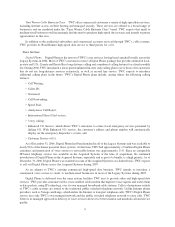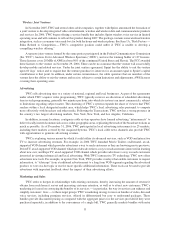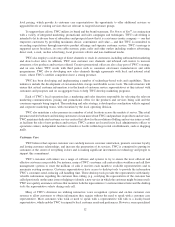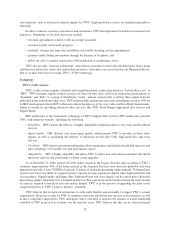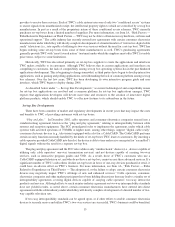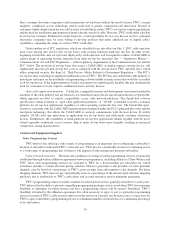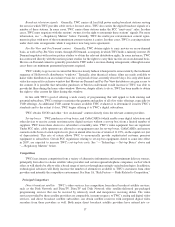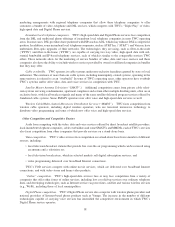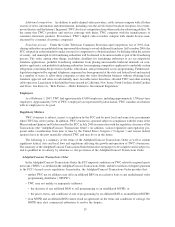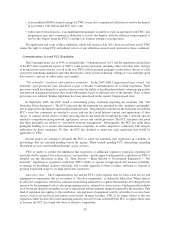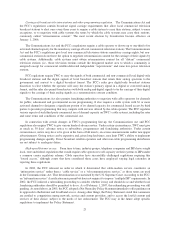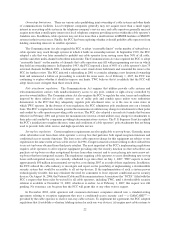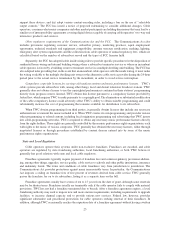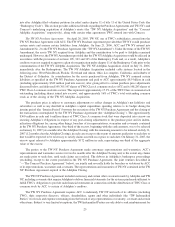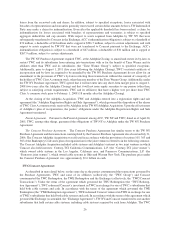Time Warner Cable 2006 Annual Report Download - page 22
Download and view the complete annual report
Please find page 22 of the 2006 Time Warner Cable annual report below. You can navigate through the pages in the report by either clicking on the pages listed below, or by using the keyword search tool below to find specific information within the annual report.Broadcast television signals. Generally, TWC carries all local full power analog broadcast stations serving
the areas in which TWC provides cable service. In most areas, TWC also carries the digital broadcast signals of a
number of these stations. In some cases, TWC carries these stations under the FCC “must-carry” rules. In other
cases, TWC must negotiate with the stations’ owners for the right to retransmit these stations’ signals. For more
information, see “— Regulatory Matters” below. Currently, TWC has multi-year retransmission consent agree-
ments in place with most of the retransmission consent stations it carries. In other cases, TWC is carrying stations
under short-term arrangements while it negotiates new long-term agreements.
Pay-Per-View and On-Demand content. Generally, TWC obtains rights to carry movies on an on-demand
basis, as well as Pay-Per-View events, through iN Demand, a company in which TWC holds a minority interest. iN
Demand negotiates with motion picture studios to obtain the relevant distribution rights. In some instances, TWC
has contracted directly with the motion picture studios for the rights to carry their movies on an on-demand basis.
Movies-on-Demand content is generally provided to TWC under a revenue-sharing arrangement, although in some
cases there are minimum guaranteed payments required.
TWC’s ability to get access to current hit films in a timely fashion is hampered to some extent by the traditional
sequence of Hollywood’s distribution “windows.” Typically, after theatrical release, films are made available to
home video distributors on an exclusive basis for a set period of time, currently about 45 days. It is only after home
video has enjoyed its exclusive window that Movies-on-Demand and Pay-Per-View distributors can gain access to
the content. It is possible that subscriber purchases of Movies-on-Demand would increase if TWC was able to
provide hit films during the home video window. However, despite efforts to do so, TWC has been unable to obtain
the right to offer current hit films during this window.
In line with TWC’s goal of offering a wide variety of programming that will appeal to both existing and
potential subscribers, TWC is trying to maximize the quantity and quality of all of its video offerings, especially its
VOD offerings. As additional VOD content becomes available TWC evaluates it to determine if it meets TWC’s
standards and to the extent it does, TWC begins offering it to TWC’s digital subscribers.
TWC obtains SVOD and other “free on-demand” content directly from the relevant content providers.
Set-top boxes. TWC purchases set-top boxes, and CableCARDs (which enable some digital televisions and
other devices to receive certain non-interactive digital services without a set-top box) from a limited number of
suppliers. TWC leases these devices to subscribers at monthly rates. TWC’s video equipment fees are regulated.
Under FCC rules, cable operators are allowed to set equipment rates for set-top boxes, CableCARDs and remote
controls on the basis of actual capital costs, plus an annual after-tax rate of return of 11.25%, on the capital cost (net
of depreciation). This rate of return allows TWC to economically provide sophisticated customer premises
equipment to subscribers. Certain FCC regulations relating to set-top box equipment, slated to come into effect
in 2007, are expected to increase TWC’s set-top box costs. See “— Technology — Set-top Boxes” above and
“— Regulatory Matters” below.
Competition
TWC faces intense competition from a variety of alternative information and entertainment delivery sources,
principally from direct-to-home satellite video providers and certain regional telephone companies, each of which
offers or will shortly be able to offer a broad range of services through increasingly varied technologies. In addition,
technological advances will likely increase the number of alternatives available to TWC’s customers from other
providers and intensify the competitive environment. See Item 1A, “Risk Factors — Risks Related to Competition.”
Principal Competitors
Direct broadcast satellite. TWC’s video services face competition from direct broadcast satellite services,
such as the Dish Network and DirecTV. DirecTV and Dish Network offer satellite-delivered pre-packaged
programming services that can be received by relatively small and inexpensive receiving dishes. The video
services provided by these satellite providers are comparable, in many respects, to TWC’s analog and digital video
services, and direct broadcast satellite subscribers can obtain satellite receivers with integrated digital video
recorders from those providers as well. Both major direct broadcast satellite providers have entered into co-
17




